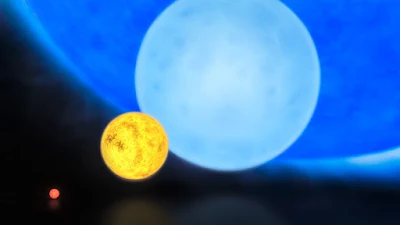Έχουν
μάζα 100 φορές μεγαλύτερη από του Ήλιου. H κεντρική περιοχή του νεφελώματος
Ταραντούλα στο μεγάλο νέφος του Μαγγελάνου. Το νέο αστρικό σμήνος R136
βρίσκεται στο κάτω δεξιό μέρος της εικόνας. The image shows the
central region of the Tarantula Nebula in the Large Magellanic Cloud. The young
and dense star cluster R136 can be seen at the lower right of the image. This
cluster contains hundreds of young blue stars, among them the most massive star
detected in the Universe so far. Using the NASA/ESA Hubble Space Telescope
astronomers were able to study the central and most dense region of this
cluster in detail. Here they found nine stars with more than 100 solar masses.
Credit: NASA, ESA, P Crowther (University of Sheffield)
Μια
διεθνής ομάδα αστρονόμων ανακάλυψε εννέα άστρα-τέρατα, τα οποία έχουν μάζα πάνω
από 100 φορές μεγαλύτερη από αυτή του Ήλιου και τα οποία ανήκουν στο ίδιο
σμήνος άστρων. Η ανακάλυψη έγινε με τη βοήθεια του διαστημικού τηλεσκοπίου
«Χαμπλ».
Τα
τεραστίων διαστάσεων άστρα ανήκουν σε ένα νεανικό αστρικό σμήνος με την
ονομασία R136, το οποίο είναι το μεγαλύτερο σμήνος κολοσσιαίων άστρων, που έχει
ανακαλυφθεί μέχρι σήμερα. Βρίσκεται στο Νεφέλωμα Ταραντούλα, μέσα στο Μεγάλο
Μαγγελανικό Νέφος, σε απόσταση περίπου 170.000 ετών φωτός από τη Γη.
Οι
ερευνητές, με επικεφαλής τον καθηγητή Πολ Κράουδερ του Τμήματος Φυσικής και
Αστρονομίας του βρετανικού Πανεπιστημίου του Σέφιλντ, έκαναν τη σχετική
δημοσίευση στο περιοδικό «Monthly Notices»
της Βασιλικής Εταιρείας Αστρονομίας της Βρετανίας.
The left side of
this collage shows the central part of the young star cluster R136 as it can be
seen in the ultraviolet. Due to the high-resolution of Hubble in the
ultraviolet the individual stars in this dense cluster can be resolved and
studied. The right side shows a pseudo-image, created from the UV spectra
collected with the Space Telescope Imaging Spectrograph (STIS). These spectra
have been used by scientists to determine the properties of the stars in R136.
The boundary of the 17 slit locations is outlined in white in the left image.
The long-slit data from the spectrograph have been compressed to the width of
the slits and stacked to create a pseudo-image. This allows the slit locations
to be matched to stars in the left image. Credit: ESA/Hubble, NASA, K.A.
Bostroem (STScI/UC Davis)
Τα
εννέα άστρα-τέρατα, εκτός από το εντυπωσιακό μέγεθός τους, είναι τόσο λαμπερά,
που από κοινού η λάμψη τους είναι 30 εκατομμύρια φορές πιο φωτεινή από τον
Ήλιο.
Το
2010, η ίδια ερευνητική ομάδα είχε εντοπίσει μέσα στο ίδιο αστρικό σμήνος
τέσσερα τεράστια άστρα, με μάζα το καθένα 150 φορές μεγαλύτερη του Ήλιου. Η νέα
έρευνά τους έρχεται τώρα να προσθέσει πέντε ακόμη, που έχουν το καθένα πάνω από
100 ηλιακές μάζες, ανεβάζοντας τον συνολικό αριθμό σε εννέα.
Left to right: a red dwarf, the Sun, a blue dwarf, and R136a1. R136a1 is not the largest known star in terms of radius or volume, only in mass and luminosity. Image via Wikipedia.
Left to right: a red dwarf, the Sun, a blue dwarf, and R136a1. R136a1 is not the largest known star in terms of radius or volume, only in mass and luminosity. Image via Wikipedia.
Όμως
παρά τη νέα ανακάλυψη, δεν καταρρίφθηκε το ρεκόρ του μεγαλύτερου γνωστού άστρου
στο Σύμπαν, του R136a1, που είναι τουλάχιστον 250 φορές μεγαλύτερο από τον
Ήλιο.
Στο
ίδιο σμήνος οι επιστήμονες εντόπισαν δεκάδες ακόμη πολύ μεγάλα άστρα, με μάζες
πάνω από 50 φορές μεγαλύτερες του Ήλιου. Οι επιστήμονες δεν είναι σίγουροι μέσω
ποιων μηχανισμών δημιουργήθηκαν τόσα πολλά μεγάλα άστρα στο ίδιο νεανικό
σμήνος.
Πηγή:
"The R136 Star Cluster Dissected with Hubble Space Telescope/STIS. I.
Far-Ultraviolet Spectroscopic Census and the Origin of He II 1640 in Young Star
Clusters," 2016 May 1, Monthly Notices of the Royal Astronomical
Society mnras.oxfordjournals.org/content/458/1/624




Δεν υπάρχουν σχόλια:
Δημοσίευση σχολίου